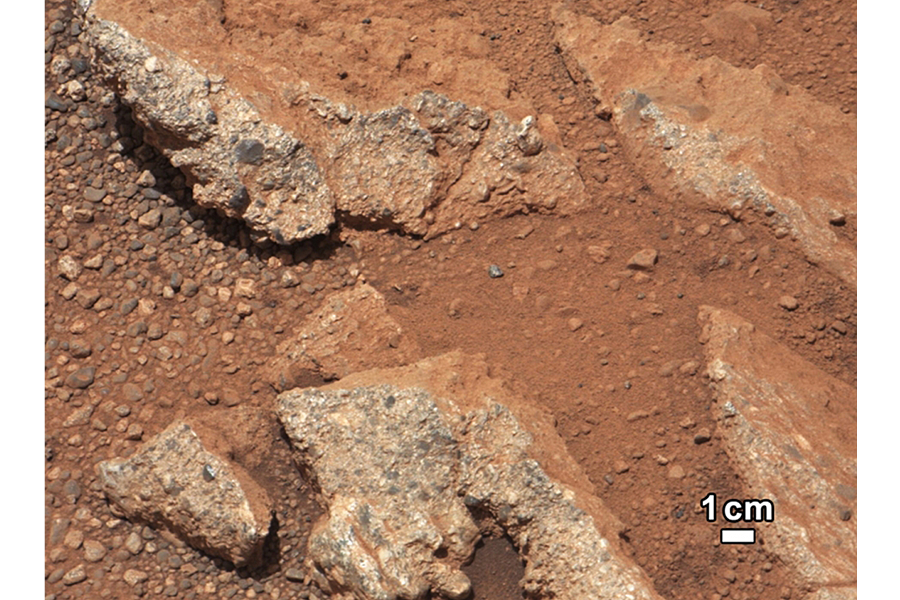Martian river likely carried pebbles tens of miles: What could it mean?
Loading...
Currently cold and dry Mars may have had rivers some 3 billion years ago.
Scientists now have evidence that a river once flowed for tens of miles through Gale Crater on the Red Planet.
Pebbles, captured in images beamed back to Earth by the Mars Curiosity rover in 2012, alerted scientists to the possibility of rivers on Mars – and water has long been considered a prerequisite for life.
Those rounded Martian rocks traveled some 30 miles from their original home, likely carried along by a vigorous ancient river, say researchers.
Using just the shape of the pebbles, researchers were able to estimate the distance they had traveled. The geophysicists and mathematicians reported their findings in a paper Tuesday in the journal Nature Communications.
“An object’s shape can itself tell you a lot,” said study co-author and mathematician Gábor Domokos in a news release. “If you go to the beach, natural history is written underneath your feet. We started to understand that there is a code that you can read to begin to understand that history.”
As rocks are carried along with a river’s current, they rub against other rocks in the riverbed. This abrasion leaves the rocks progressively smoother and rounder as they travel.
On Earth, scientists can examine other environmental factors that might help determine the distance a pebble has traveled. But the Martian pebbles have only been available to scientists via the images captured by Curiosity.
So the researchers looked at existing data and examined rivers on Earth, namely one flowing down a Puerto Rican mountain, to create a method for examining the image of Martian pebbles.
“We started at the headwaters, where chunks of angular rock are breaking off from the walls of the stream, and went downstream,” Dr. Jerolmack said. “Every few hundred meters we would pull thousands of rocks out and take images of their silhouette and record their weight.”
Using data gathered previously in conjunction with this new data, the researchers spotted a trend of shape evolution and mass loss as the rocks were transported downstream. From this, they created a mathematical model to calculate the data in reverse and determine how far a rock had traveled from its size and shape.
“Thousands of years ago, Aristotle pondered the question of pebbles on the beach and how they become rounded,” Jerolmack said. “But until recently, descriptions of pebble shape have been qualitative, and we lacked a basic understanding of the rounding process.”
“Now we have a new tool we can use to help reconstruct ancient environments on Earth, Mars and other planetary bodies where rivers are found such as Titan,” Jerolmack said.
A more precise look back at the rocks’ path
Scientists have already reported that the shape of these pebbles suggests a riverbed that flows for miles in May 2013 in the journal Science.
"In order to have moved and formed these rounded pebbles, there must have been flowing water with a depth of between 10 centimeters (4 inches) and 1 meter (3.3 feet) and a flow rate of about 1 meter per second – or 3.6 km/h (2.2 mph) – slightly faster than a typical natural Danish stream," Morten Bo Madsen, head of the Mars research group at the Niels Bohr Institute, said in a statement at the time.
This 2013 report may have outlined many details of the ancient Martian river suggested by these pebbles, but it’s this current study that pins down just how far those Martian rocks traveled.
Other signs of water – and life
Rivers may not have been the only bodies of water on Mars billions of years ago. The river-systems likely flowed into lakes.
The Curiosity rover led researchers to find sediment deposited into Gale Crater on the Red Planet, much in the same way deposits build up in lakes on Earth.
Although liquid water may have been plentiful on Mars billions of years ago, the planet may not be completely dried out. Scientists found evidence of salt water, ebbing and flowing with the seasons.
The amount of water currently on the planet seems to be small, but water seems to be key in making an environment hospitable to life.
Finding evidence of water is particularly exciting, John Grunsfeld, NASA's associate administrator for the agency's science mission directorate, told The Christian Science Monitor's Pete Spotts, "because it suggests that it would be possible for there to be life today on Mars."








